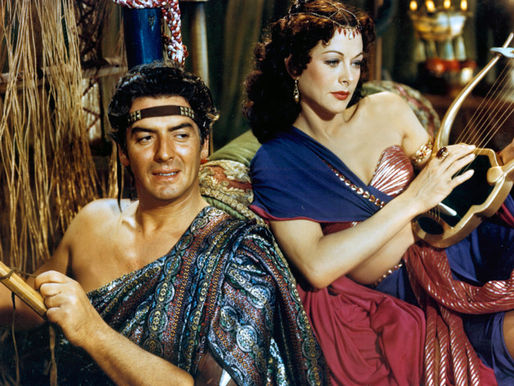top of page
Search
Film Reviews
Reviews of films from 1930's through to 1999.


The Andromeda Strain (1971)
The Andromeda Strain is a taut, cerebral science fiction thriller that brought a new kind of realism to the genre in the early 1970s. Adapted from Michael Crichton’s breakout 1969 novel and directed by Robert Wise—already well-established from films like The Day the Earth Stood Still and West Side Story—this film stands apart from its contemporaries with a tone of cold precision and scientific authenticity.

Soames Inscker
5 min read


The Day the Earth Stood Still (1951)
Few science fiction films of the 1950s have had the enduring cultural, philosophical, and cinematic impact of The Day the Earth Stood Still. Released during the height of Cold War anxiety and directed with precision and restraint by Robert Wise, this film broke new ground by fusing speculative science fiction with sharp social commentary.

Soames Inscker
4 min read


Born to Kill (1947)
Released in 1947 by RKO and directed by Robert Wise, Born to Kill is one of the darkest, most nihilistic examples of classic film noir. With a story centred on psychopathy, obsession, and moral collapse, it pushed the boundaries of what was acceptable in post war Hollywood. The film tells the story of a dangerous man and the even more dangerous woman who finds herself drawn to him, not despite his violence—but perhaps because of it.

Soames Inscker
4 min read


The Set-Up (1949)
The Set-Up (1949) is a film that, despite its modest budget and short runtime, remains one of the most compelling entries in the film noir and boxing film canon. Directed by Robert Wise and starring Robert Ryan and Audrey Totter, the movie presents a tense, real-time narrative of a washed-up boxer who refuses to go down quietly—both literally and metaphorically.

Soames Inscker
4 min read


Out of Africa (1985)
Out of Africa is a sumptuous and reflective epic adapted from the memoirs of Danish author Karen Blixen (writing as Isak Dinesen), chronicling her years in British East Africa during the early 20th century. Released in 1985 and directed by Sydney Pollack, the film is a sprawling romantic drama that fuses breathtaking visuals with introspective narration, political subtext, and personal tragedy.

Soames Inscker
4 min read


The Way We Were (1973)
The Way We Were is a film that pulses with nostalgia, regret, and yearning—an earnest, bittersweet exploration of love that could not withstand the weight of time and ideology. Directed by Sydney Pollack and released in 1973, it pairs two major stars at the peak of their magnetism: Barbra Streisand, with her fiercely intelligent presence, and Robert Redford, at his most golden and effortlessly charismatic.

Soames Inscker
4 min read


They Shoot Horses, Don’t They? (1969)
They Shoot Horses, Don’t They? is a harrowing and haunting film set against the backdrop of a Depression-era dance marathon—a bizarre endurance contest that serves as both a literal and metaphorical crucible for human suffering.

Soames Inscker
4 min read


The Slender Thread (1965)
The Slender Thread is a poignant, tightly wound psychological drama that explores human despair, responsibility, and the tenuous connections that can hold a life together. Directed by Sydney Pollack in his feature debut, the film is based on a true story originally published in Life magazine, dramatizing a suicide prevention hotline worker’s desperate attempt to save a woman’s life through a telephone call.

Soames Inscker
4 min read


Advise and Consent (1962)
Advise & Consent (1962) is a tense, cerebral, and surprisingly daring political drama directed by Otto Preminger, adapted from Allen Drury’s Pulitzer Prize-winning novel of the same name. It offers a razor-sharp look at the inner workings of the United States Senate and the murky interplay of politics, personal secrets, ideology, and power.

Soames Inscker
4 min read


Anatomy of a Murder (1959)
Anatomy of a Murder is not only one of the most enduring courtroom dramas ever filmed, but also a prime example of how cinema in the late 1950s was evolving—pushing boundaries, addressing adult themes, and striving for psychological realism. Directed by Otto Preminger and based on a best-selling novel by Michigan Supreme Court Justice John D. Voelker, the film combines taut legal suspense with rich character study, anchored by a career-highlight performance from James Stewart

Soames Inscker
4 min read


The Man With The Golden Arm (1955)
The Man with the Golden Arm is not only a landmark film in the career of Frank Sinatra but also a pivotal moment in American cinema’s confrontation with taboo subject matter. Directed by Otto Preminger and adapted from Nelson Algren’s gritty 1949 novel, the film centres on drug addiction—an explosive topic that the Production Code Administration had long deemed unfilmable.

Soames Inscker
4 min read


The Moon is Blue (1953)
When The Moon Is Blue was released in 1953, it caused a seismic stir—not because of any wild visual spectacle or ground-breaking technical achievement, but due to its script. This modest romantic comedy made headlines for its frank (by 1950s standards) treatment of courtship, chastity, and feminine assertiveness.

Soames Inscker
3 min read


Laura (1944)
Laura (1944) is one of the most celebrated films of the film noir genre, a hauntingly elegant blend of romance, mystery, and psychological complexity. Directed by Otto Preminger and adapted from Vera Caspary’s novel, Laura stands as one of the defining examples of mid-20th-century Hollywood's engagement with darker, morally ambiguous storytelling. It is a film that combines exquisite cinematography, striking performances, and a narrative steeped in mystery and intrigue.

Soames Inscker
7 min read


Samson and Delilah (1949)
Samson and Delilah (1949), directed by the legendary Cecil B. DeMille, is a grandiose spectacle of biblical proportions that combines larger-than-life action, dramatic storytelling, and lavish Technicolor cinematography to create a timeless epic.

Soames Inscker
6 min read


My Son John (1952)
My Son John (1952) is an American film that brings the political tensions of the early Cold War era directly into the domestic sphere. Directed by Leo McCarey, a filmmaker known for both his comedy and dramatic sensibilities, the film tackles the sensitive subject of communism, its threat to American values, and the personal cost of ideological betrayal.

Soames Inscker
6 min read


Going My Way (1944)
Released during the final years of World War II, Going My Way (1944) is a classic example of a film that blends humour, sentimentality, and musicality to create a lasting emotional impact.

Soames Inscker
6 min read


Make Way For Tomorrow (1937)
Make Way for Tomorrow (1937) is a heart-wrenching, bittersweet exploration of aging, family dynamics, and the often unspoken emotional struggles that come with growing old.

Soames Inscker
6 min read


Ruggles of Red Gap (1935)
Ruggles of Red Gap (1935) is a charming and whimsical comedy that represents a delightful intersection of British and American sensibilities in film during the mid-1930s.

Soames Inscker
6 min read


Outcast of the Islands (1951)
Outcast of the Islands (1951) is a richly layered drama set in the remote, tropical environment of the Malay Archipelago, adapted from Joseph Conrad's novel of the same name.

Soames Inscker
6 min read


The Man Between (1953)
The Man Between (1953) is a striking example of British post-war cinema, mixing elements of noir, suspense, and Cold War tension. Directed by Carol Reed, known for his mastery of atmospheric tension in films like The Third Man (1949), this film explores themes of espionage, political intrigue, and moral ambiguity in the divided city of Berlin during the early years of the Cold War.

Soames Inscker
6 min read
bottom of page


